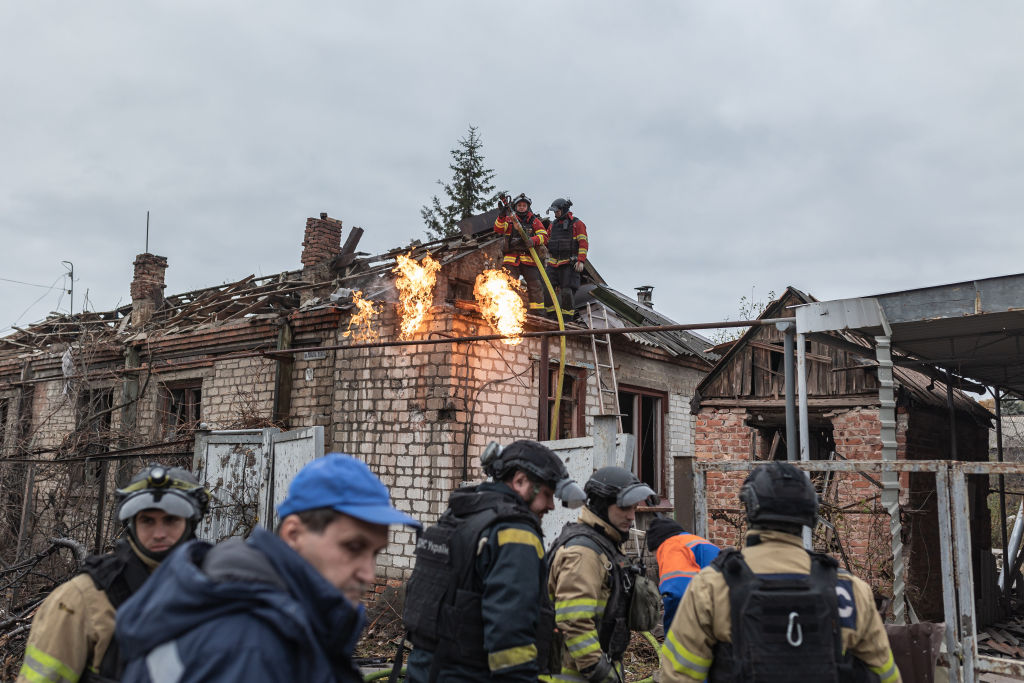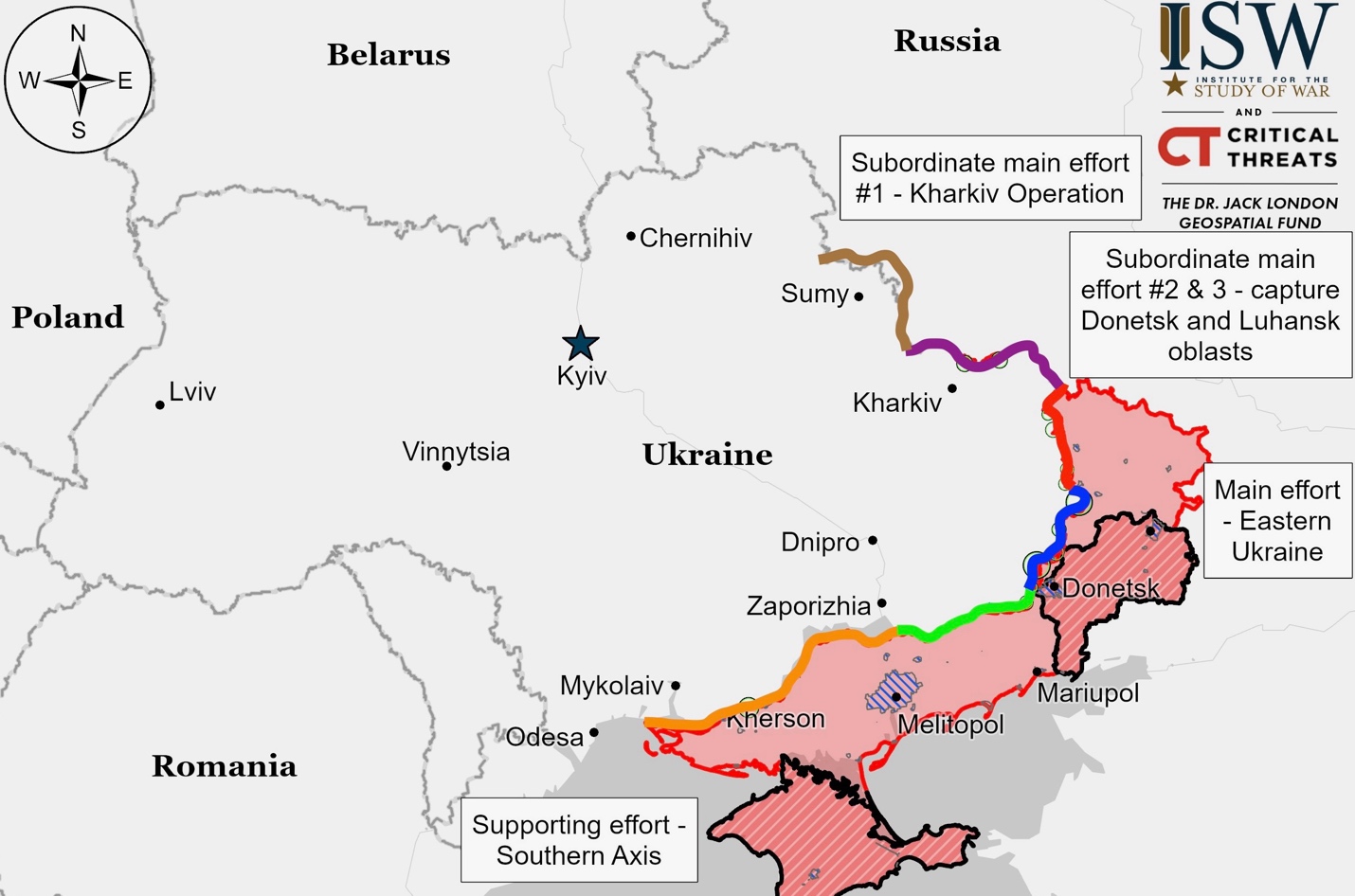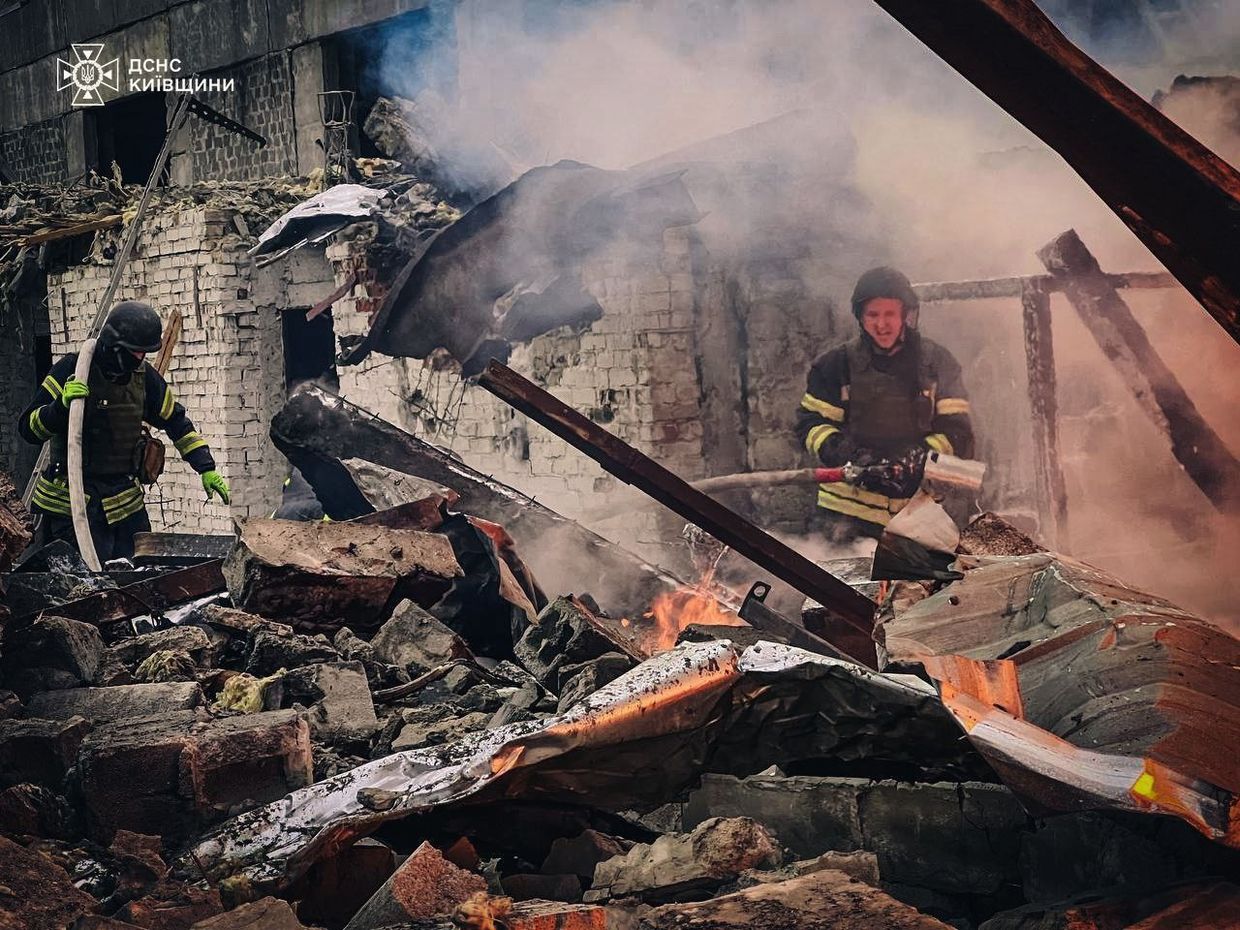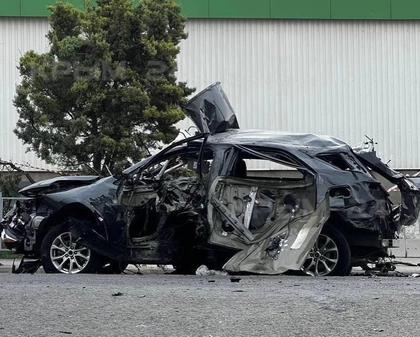Summary of the Day:
Russian forces advanced along multiple fronts today, gaining ground near Toretsk, Kurakhove, and Vuhledar, while also pushing forward in the Donetsk-Zaporizhia Oblast border area. Ukrainian forces achieved a tactical success, regaining positions near Chasiv Yar. Military analysts note that Russia continues to heavily rely on refurbished tanks and armored vehicles from storage to replace combat losses, raising concerns about their long-term sustainability.
In a significant development, both South Korean and US intelligence agencies confirmed that North Korean troops have actively joined combat operations alongside Russian forces in Kursk Oblast. US State Department reports indicate over 10,000 North Korean troops initially deployed to eastern Russia before moving to combat positions in the western region.
The Ukrainian Security Service (SBU) conducted a successful operation in occupied Crimea, assassinating Captain First Rank Valery Trankovsky, a Russian Black Sea Fleet official, in Sevastopol through a car explosion. Trankovsky had previously ordered cruise missile strikes on Ukrainian civilian targets in 2022.
Meanwhile, the Kremlin is taking a hard stance ahead of Trump’s inauguration, with Foreign Minister Lavrov explicitly rejecting proposals to freeze the current frontline. Russian officials continue to demand complete Ukrainian capitulation as a prerequisite for peace talks, insisting that Western military aid to Ukraine must cease before any negotiations can begin.
Picture of the Day:
 Ukrainian emergency services extinguish a fire in a house after Russian shelling in the city of Kostiantynivka, Ukraine. (Diego Herrera Carcedo/Anadolu via Getty Images)
Ukrainian emergency services extinguish a fire in a house after Russian shelling in the city of Kostiantynivka, Ukraine. (Diego Herrera Carcedo/Anadolu via Getty Images)
Beyond Ukraine – The March Towards World War
President-Elect Trump’s selection of Mike Waltz as national security adviser for 2025 signals potential shifts in global security relationships. As one of the most influential foreign policy positions in U.S. government, Waltz’s mixed stance on Ukraine aid and his call for clearer strategic objectives could impact international stability, particularly in Eastern Europe. His voting record shows declining support for Ukraine funding in 2024, despite earlier backing in 2022-2023, raising questions about future U.S. commitment to European allies. While Waltz is described as “hawkish” on China and experienced in dealing with threats from Russia, Iran, and global terrorism, his recent demands for strategic clarity before approving more Ukraine aid suggests a possible restructuring of U.S. international security commitments. This appointment, alongside Marco Rubio’s expected role as Secretary of State, could significantly reshape U.S. engagement in global peacekeeping efforts.
The Path to Peace
President-elect Trump plans to “soon” appoint a Ukrainian peace envoy to lead negotiations on ending Russia’s war, according to Fox News sources. The position will be like the role Kurt Volker held as U.S. Special Representative for Ukraine from 2017 to 2019 and, like Volker’s position, is expected to be unpaid. The unnamed source indicated they will select “a very senior special envoy, someone with a lot of credibility, who will be given a task to find a resolution, to get to a peace settlement.”
Russian officials are setting firm conditions for potential peace talks with Ukraine ahead of Trump’s upcoming presidency. On November 13, Russian Foreign Ministry Spokesperson Maria Zakharova stated that peace would only be possible if Western military aid to Ukraine stops. Foreign Minister Sergei Lavrov also indicated that Trump’s presidency wouldn’t change Russia’s stance, and rejected proposals to freeze the current frontline, calling them worse than the 2014 Minsk Agreements. These statements suggest Russia maintains its original position, seeking Ukraine’s complete surrender rather than showing willingness to compromise.
Russian Foreign Minister Lavrov’s rejection of a potential frontline freeze reinforces Russia’s unchanged position, seeking Ukraine’s full surrender as outlined by President Putin in June 2024. Despite Putin’s public statements about improving US-Russian relations, recent comments from Russian officials suggest they expect the incoming Trump administration to favor Russian interests without requiring concessions from Moscow. This stance comes as reports indicate Trump plans to appoint a Ukrainian peace envoy and announce national security cabinet positions.
Situation On The Land, Sea, and Air in Ukraine
Russian forces are now using drones with fiber optic wires in Kursk Oblast to counter Ukrainian electronic warfare jamming, according to a Russian military blogger. Similar drones have also been deployed in Donetsk and Zaporizhia regions.

Ukrainian Operations in the Russian Federation – Initiative None
Russian forces attacked within Ukraine’s Kursk Oblast without confirmed advances. Russian sources claimed gains near Novoivanovka, Zeleny Shlyakh, Darino, Kurylivka, and Plekhovo. A Ukrainian soldier reported that Russian forces conducted daily platoon-sized attacks using 4-6 armored vehicles. Russian sources also claimed they repelled Ukrainian attacks near Alexandriya, Nizhniy Klin, Novaya Sorochina and Novoivanovka.
South Korea’s National Intelligence Service (NIS) and US State Department confirmed that North Korean troops are actively fighting alongside Russian forces in western Kursk Oblast. According to US State Department Spokesperson Vedant Patel, over 10,000 North Korean soldiers initially deployed to eastern Russia, completed training, and have now moved to combat positions. This confirms earlier reports from Ukrainian intelligence and Defense Minister Rustem Umerov about North Korean military involvement in the region.
Ukrainian forces struck a fuel depot near Stary Oskol in Russia’s Belgorod Oblast on November 12, causing a fire. Both Ukrainian military officials and Belgorod’s Governor Vyacheslav Gladkov confirmed the drone attack on the Oskolneftesnab facility. Ukrainian officials noted that destroying such facilities disrupts Russian military logistics.
Kharkiv Front – Initiative Russia
Russian forces attacked near Vovchansk, northeast of Kharkiv City but failed to make any advances.
Luhansk Front – Initiative Russia
Russian forces attacked along the Kupyansk-Svatove-Kreminna line without confirmed advances. Russian sources claimed small gains near Moskovka, Borova, Kruhlyakivka, Vyshneve, Pershotravneve, and Torske. Ukrainian forces repelled a four-wave Russian attack using 15 armored vehicles in the Kupyansk area, reportedly destroying all vehicles. Fighting continued near Lozova, Kolisnykivka, Kruhlyakivka, Zahryzove, Pershotravneve, Cherneshchyna, Hrekivka, Novomykhailivka, Terny, Zarichne, and Torske. Russian forces have switched from infantry to mechanized assaults, particularly near Borova, as seasonal weather affects their operations.
Donetsk Front – Initiative Russia
Siversk
Russian forces launched attacks near Verkhnokamyanske, east of Siversk, but failed to gain ground. While Ukrainian sources claim they repelled a major Russian mechanized assault in the Siversk area, the details and location remain unconfirmed. Russian volunteer drone operators are reportedly active near Soledar, south of Siversk.
Chasiv Yar
Ukrainian forces recovered positions near Chasiv Yar retaking ground northeast of Orikhovo-Vasylivka and in a mine east of Stupochky. While Russian sources claimed advances north and southeast of Chasiv Yar, these claims remain unverified.
Toretsk
Russian forces advanced into central Toretsk, reaching Enhelsa Street. While a Russian military blogger claims 70% control of the city, independent assessments indicate Russians control about 23% of Toretsk. Fighting continues around Toretsk and nearby settlements of Shcherbynivka, Nelipivka, and Sukha Balka.
Pokrovsk
Russian forces continued attacks near Pokrovsk. While Russian sources claimed advances near Petrivka and Pustynka, these remain unconfirmed. Fighting continues around several settlements including Promin, Myrolyubivka, Lysivka, Krutyi Yar, Hryhorivka, Novooleksiivka, and Yurivka.
Kurakhove
Russian forces advanced near Kurakhove, capturing the settlement of Illinka and reportedly controlling about 14% of Kurakhove itself. Russian forces reportedly struck a bridge in northern Kurakhove and claim to have taken Novoselydivka, though this remains unconfirmed. Fighting continues near several settlements including Berestky, Voznesenka, and Novodmytrivka.
Southwest of Donetsk City
Russian forces advanced northwest of Vuhledar reaching a windbreak near Bohoyavlenka. They reportedly control most of Dalne. Heavy fighting continues in several locations including Antonivka, Katerynivka, Maksymilyanivka, Yelyzavetivka, Kostiantynopolske, and Trudove.
Zaporizhia Front – Initiative Russia
Zaporizhia-Donetsk Border Area
Russian forces advanced near the Donetsk-Zaporizhia Oblast border with confirmed movement southwest of Novodarivka. While Russia claimed to have captured Rivnopil, this remains unverified. Fighting continues around several settlements including Velyka Novosilka, Rivnopil, Novopil, and Makarivka, with Russian forces attempting to breach Ukrainian defenses in the area. Russian tank and drone units are reportedly operating near Pryyutne and in the Vremivka direction.
Zaporizhia Line
Ukrainian forces repelled a Russian mechanized assault near Stepove, northeast of Hulyaipole. Russian forces continued attacks near Novodanylivka and Novoandriivka in the Robotyne area. While Russia appears to be planning additional tactical assaults in Zaporizhia Oblast, Ukrainian officials state they lack the strength to directly attack Zaporizhzhia City, suggesting recent rumors of such attacks are meant to cause panic.
Kherson (Dnipro River) Front – Initiative Russia
Fighting continues along the eastern bank of the Dnipro River in Kherson Oblast with no confirmed changes to front line positions.
Ukraine News
Russia launched a major combined attack on Ukraine using various missiles and 90 drones from multiple launch sites, marking the first such missile-drone assault on Kyiv since September 1. Ukrainian forces intercepted several missiles and 37 drones across multiple regions, while 47 drones were disabled by electronic warfare, with some straying into Belarus. The attacks caused damage in Kyiv’s Brovarskyi Raion and struck Kharkiv City using hard-to-detect Molniya-1 drones. The strikes also targeted energy infrastructure in Ukraine’s Sumy region, where Shahed drones hit critical facilities in the Shostka community, damaging heating infrastructure and leaving the city without heat as winter approaches, leading to power restrictions for businesses in Kyiv.
Ukraine’s Foreign Ministry denied reports that Kyiv plans to develop nuclear weapons, reaffirming its commitment to the Non-Proliferation Treaty and IAEA monitoring. The denial came after The Times reported that Ukraine could develop a basic nuclear bomb “within months” if U.S. military aid ceased under a potential Trump presidency. The controversy follows President Zelensky’s earlier comments about Ukraine needing either NATO membership or nuclear capabilities for protection, which he later clarified was meant to highlight the failures of the 1994 Budapest Memorandum, under which Ukraine gave up its nuclear arsenal for security guarantees from the U.S., UK, and Russia.
Military donations in Ukraine have significantly declined in 2024, with major charities reporting drops of 20% or more. Major organizations like Come Back Alive and the Serhiy Prytula Foundation have seen donations decrease by about one-fifth, while Reactive Post reports a 40% decline compared to 2023. The Prytula Foundation raised 1.4 billion hryvnias ($34 million) in 2024, a small fraction of Ukraine’s $50 billion military budget. Charity leaders attribute the decline to economic challenges, power outages, declining incomes, and rising living costs as more Ukrainians leave the country. In response, President Zelensky announced a new eSupport program launching December 1, providing each Ukrainian with 1,000 hryvnias ($24) that can be redirected to military donations.
Marsh McLennan, a leading risk management company, is preparing war insurance coverage for both cargo ships in Ukraine’s Black Sea corridor and potential civilian flights from Lviv starting in January 2025. Senior partner Crispin Ellison indicates that while flight resumption depends on military conditions and government approval, insurance premiums should be “affordable though not cheap.” The company has already successfully launched “Unity,” an insurance program for Black Sea cargo ships, in partnership with the Ukrainian government and several banks, leading to an 80% reduction in shipping insurance rates. The initiative came after Ukraine regained control of offshore drilling platforms near Crimea, which improved security in the grain corridor. However, wider insurance coverage in Ukraine remains limited due to a blanket Russia-Ukraine-Belarus exclusion by global insurers.
Serhiy Hryhorovych, founder of Ukrainian gaming studio GSC Game World, has offered his Rolls Royce (valued at $300,000-$500,000) to anyone who destroys the Russian frigate “Admiral Grigorovich” of the Black Sea Fleet. In an interview with YouTuber Volodymyr Zolkin, Hryhorovych explained his offer stems from the frigate “disgracing” his family name, as his surname in Russian spelling matches the vessel’s name. Hryhorovych’s studio, known for the “STALKER” gaming franchise, recently released the original trilogy on Nintendo Switch and is preparing to launch “STALKER 2: Heart of Chernobyl” on November 20, despite development challenges caused by Russia’s invasion of Ukraine.
Innocent Victims Of War
The casualty count of civilians in the past 24 hours: (Russian War Crimes)
DEATHS: 0 INJURIES: 16
A Russian drone struck an apartment building in Kharkiv’s Saltivskyi district causing damage to nearby buildings, cars, and public transport infrastructure. While initially reported as injured, two residents received medical assistance but had no physical injuries. Four people required medical attention: two 74-year-olds were hospitalized with shrapnel wounds, an 84-year-old woman was treated for a hypertensive crisis, and a 53-year-old woman suffered shock.
Russia launched a combined drone and missile attack on Kyiv and its surrounding region. The assault, which included cruise missiles, Iskander-M or North Korean ballistic missiles, and attack drones, resulted in one injury – a 48-year-old man who suffered head trauma from falling debris. The attack also caused a warehouse fire in the Brovary district near Kyiv.
Russian forces attacked 20 settlements in Kherson Oblast, including Kherson city, striking a fire department, an administrative building, and an educational institution. The attacks wounded 10 people.
Russian forces attacked Donetsk Oblast, injuring one person in the settlement of Dachne.
 A fire broke out in a warehouse in the Brovary district, Kyiv Oblast, Ukraine, following a Russian strike. (State Emergency Service).
A fire broke out in a warehouse in the Brovary district, Kyiv Oblast, Ukraine, following a Russian strike. (State Emergency Service).
Ukraine’s Allies
U.S. Secretary of State Antony Blinken and Ukrainian Foreign Minister Andrii Sybiha met in Brussels for bilateral talks, where Blinken pledged increased U.S. military assistance to Ukraine before President Biden’s term ends in January 2025. The assistance includes artillery, air defense, armored vehicles, and expediting over $6 billion in already approved funding. During the emergency visit, they discussed North Korea’s involvement in Russia’s war, battlefield escalation, and the U.S. State Department reaffirmed support for Ukraine’s defense and NATO membership path. National Security Advisor Jake Sullivan emphasized the administration’s goal of strengthening Ukraine’s position both on the battlefield and at future negotiations.
Western allies, including UK Prime Minister Keir Starmer, are working to secure long-term support for Ukraine, discussing authorization for deeper strikes into Russian territory with Western weapons and the release of $20 billion in aid. The discussions come amid concerns about future U.S. support following Donald Trump’s election victory and Germany’s political crisis. Additionally, Ukraine received a $1.35 billion grant from the U.S. through USAID for humanitarian and social programs on November 13, which will support essential public services, including education and emergency rescue services.
President-elect Trump and President Biden met in the Oval Office for a post-election discussion about the war in Ukraine and Middle East conflicts, with Trump promising to end the war within “24 hours” after taking office, though without revealing specifics. The two leaders plan to meet again before Trump’s inauguration, which Biden will attend, as part of what Trump described as a smooth transition process. Meanwhile, Secretary of State Antony Blinken announced plans to increase U.S. military assistance to Ukraine before Trump takes office in January 2025.
Trump’s cabinet selections signal potential shifts in U.S. policy toward Ukraine, including Tulsi Gabbard as director of national intelligence, who has opposed U.S. support for Ukraine, echoed Putin’s invasion justification, and warned about nuclear escalation risks. Rep. Matt Gaetz, nominated as attorney general, has opposed Ukraine aid and previously proposed redirecting those funds to build a U.S.-Mexico border wall. Other key appointments include Pete Hegseth as defense secretary, who has downplayed Russia’s invasion; Marco Rubio as secretary of state, who advocates for a negotiated settlement rather than helping Ukraine regain territory; and Michael Waltz as national security advisor, whose Ukraine support has wavered since 2022. Trump also appointed Elon Musk and Vivek Ramaswamy to lead a new Department of Government Efficiency – with Musk suggesting Ukraine cede territory to Russia and Ramaswamy opposing Ukraine’s NATO admission. Notable pro-Ukrainian Republicans Mike Pompeo and Nikki Haley were excluded from his team.
While Ukrainian officials see “moderate reasons for optimism” in some appointments like Rubio and Waltz, they express concern about Musk and Ramaswamy’s appointments, though David Arakhamia, head of Zelensky’s parliamentary group, suggests perspectives may change once appointees access classified intelligence. Additionally, Trump’s transition team is reportedly preparing to dismiss numerous military officers at the Pentagon, including potential members of the Joint Chiefs of Staff, particularly those connected to former chairman Mark Milley – an unprecedented move that, combined with Hegseth’s nomination as Defense Secretary, could significantly impact U.S. military policy and support for Ukraine.
Germany is heading for snap elections in February 2025 following the collapse of Chancellor Olaf Scholz’s coalition government, with Friedrich Merz, leader of the center-right CDU/CSU party and current frontrunner, promising stronger support for Ukraine, including potentially delivering long-range Taurus missiles that Scholz has refused to provide. This leadership change comes at a critical time for Ukraine, as Russia gains ground and Trump’s return to the White House may reduce U.S. support, though analysts caution that even if Merz wins, Germany faces significant challenges in increasing aid, including budget constraints, growing public Ukraine fatigue, and potential coalition negotiations that could limit policy changes. Currently, Germany, Ukraine’s second-largest military donor after the U.S., has allocated 8 billion euros in military aid for 2024, though the 2025 budget shows only half that amount, and will provide Ukraine with its sixth IRIS-T air defense system by year’s end, having ordered 17 additional systems, following a call between President Zelensky and Chancellor Scholz where they discussed continued defense cooperation and agreed to maintain Ukraine Defense Contact Group meetings.
Estonia’s undersecretary for political affairs, Martin Roger, affirmed his country’s continued support for Ukraine and NATO commitments during the Kyiv International Economic Forum. Roger emphasized that Russia’s war poses a significant threat to European security, leading NATO members to increase defense spending beyond the current 2% GDP minimum. He reaffirmed Estonia’s support for Ukraine’s NATO membership, noting that Ukraine’s path to NATO is “irreversible.” Regarding potential changes in U.S. leadership after the November elections, Roger stated that Estonia’s commitment to transatlantic cooperation would remain unchanged, and that Tallinn would continue working with Washington regardless of who wins the presidency. He also highlighted Estonia’s ongoing efforts to counter Russian disinformation campaigns through information sharing with allies and increased societal resilience measures.
Life in Russian Occupied Ukraine
Ukraine’s Human Rights Commissioner Dmytro Lubinets reports that while 1,002 Ukrainian children have been successfully returned from Russia and occupied territories, nearly 20,000 remain forcibly relocated by Moscow. During a recent meeting in Belarus with Russian Commissioner Tatyana Moskalkova, Lubinets accused Russia of deliberately delaying the children’s return process. He also expressed concern about the 1.5 million Ukrainian children currently living in occupied territories, suggesting the number of deportations could increase further, while noting that Russia provides no information about the affected children.
Ukrainian Security Service (SBU) reportedly assassinated Russian Black Sea Fleet Captain First Rank Valery Trankovsky, 47, Chief of Staff of the 41st missile boat brigade, when an explosive device planted on his car detonated outside a supermarket on Taras Shevchenko Street in occupied Sevastopol, Crimea, the main base of Russia’s Black Sea Fleet. The SBU claimed responsibility, stating Trankovsky was targeted for his role in ordering Russian cruise missile strikes on Ukrainian civilian targets, including a 2022 attack on a Vinnytsia shopping mall that killed 29 civilians. Sevastopol’s occupation governor Mikhail Razvozhaev confirmed a car explosion killed a Russian servicemember, suggesting possible sabotage but didn’t identify the victim.
 The car suspected of belonging to a Russian naval officer destroyed by an IED in Sevastopol. (Telegram)
The car suspected of belonging to a Russian naval officer destroyed by an IED in Sevastopol. (Telegram)
Russia News
Russian President Vladimir Putin rejected a proposal to merge Russia’s three largest oil companies: Gazprom Neft, Rosneft, and Lukoil. The merger, proposed by Russian Energy Minister Sergei Tsivilev, was declined due to concerns about sanctions circumvention and potential oil production reduction, despite potential benefits of access to Lukoil’s UAE trading operations. While the Wall Street Journal first reported these merger talks on November 9, both the Kremlin and Rosneft have denied their occurrence.
Recent contradictory reports about the proposed Russian oil merger suggest internal power struggles among Putin’s close associates. While Energy Minister Sergei Tsivilev attempted to leverage his family ties to Putin to promote the merger, Putin ultimately sided with energy executives Igor Sechin and Alexey Miller, despite his reported desire for greater Kremlin control over oil production. The Wall Street Journal’s initial merger report, which named Sechin as a key figure, prompted Rosneft to deny any “insidious intentions” to take over other oil companies’ assets.
A Moscow court ordered the arrest in absentia of International Criminal Court (ICC) Vice President Reine Alapini-Gansou for “illegal detention,” adding her to Russia’s wanted list. This is part of Russia’s ongoing legal campaign against ICC judges following their March 2023 arrest warrant for President Putin and Maria Lvova-Belova regarding forced deportation of Ukrainian children. The action against Alapini-Gansou follows a similar warrant for ICC judge Haykel Ben Mahfoudh, who was involved in issuing arrest warrants for former Russian Defense Minister Shoigu and military chief Gerasimov for suspected war crimes in Ukraine. The ICC has also issued warrants for Russian military commanders Sergei Kobylash and Viktor Sokolov for attacks on Ukrainian civilian infrastructure.
About thirty Russian airlines, representing 26% of domestic passenger traffic, face potential bankruptcy in 2025, according to Russia’s Izvestia newspaper. Under Western sanctions, many Russian airlines stopped making lease payments for foreign aircraft in 2022. While major carriers like Aeroflot, Ural Airlines, and S7 Airlines bought back 165 of 400 leased aircraft using National Welfare Fund money, smaller airlines are struggling. Although the government will allow debt write-offs in 2025, the required 25% income tax on these amounts may force many airlines to cease operations.
Russian War Losses (Today/Total)
| Troops +1690
716070 |
Tanks +19
9319 |
Artillery +64
20472 |
Arm. VEH +51
18947 |
Aircraft
369 |
Heli
329 |
Ships
28 |
Russia Mobilization and Defense Industrial Base
Russia is struggling to maintain its tank fleet in the Ukraine war. According to recent reports, Russia produces about 150-160 tanks monthly, with only 30% being newly manufactured while 70% are refurbished from storage. The UK intelligence suggests Russia’s stored tank reserves could be depleted by Fall 2025 at the current usage rate. Since the invasion began in 2022, Russia has lost approximately 3,558 tanks according to Oryx, an open-source tracking project. While experts believe Russia can sustain current loss rates for the next few years through storage reactivation, this strategy may not be sustainable long-term.
Russian President Vladimir Putin approved new compensation rates for soldiers wounded in Ukraine, establishing three tiers: 3 million rubles ($29,000-30,456) for “severe” injuries, 1 million rubles ($10,000-10,152) for “minor” injuries, and 100,000 rubles ($960-1,015) for “other minor injuries.” Russian military bloggers criticized the system as inadequate, noting it doesn’t fully cover medical costs for serious injuries and fails to account for varying severity of similar injury types. This comes as Russian forces suffered their highest casualties in October 2024, with 41,980 killed and wounded according to British intelligence, though Russia continues gaining territory in eastern Ukraine while offering increased financial incentives for new recruits, including a doubled sign-on bonus of 400,000 rubles ($4,600) and a record 3 million rubles ($31,200) bonus in Belgorod Oblast.
Source Material
Institute for the Study of War – understandingwar.org
The Kyiv Independent – kyivindependent.com
Kyiv Post – kyivpost.com
